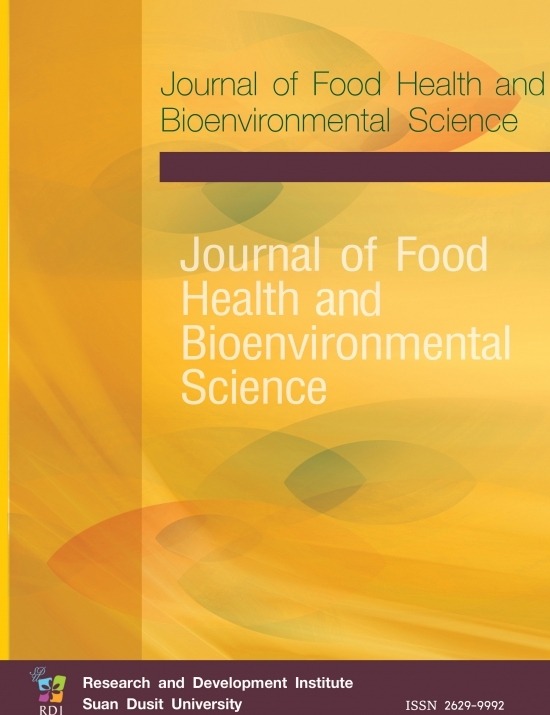Mentum Deformities of Chironomid larvae in Huai Kakang stream (Northeastern Thailand) and Lead Exposure Effect
Keywords:
Mouthpart Deformities, Lead, Stream and River Pollution, ChironomidsAbstract
Deformities in the mouthparts of Chironomidae larvae, particularly of the teeth on the mentum, have been proposed as a bioindicator of anthropogenic impacts on water quality. Therefore, this study was used the deformities of Chironomid larvae for assessing water quality of Huai Kakang stream (Maha Sarakham Province, Thailand). The effect of lead exposure in the mentum deformities of Chironomus spp. was also studied to confirm the relationship between the toxicant and the deformities. Water, sediment and chironomids larvae, were collected from Huai Kakang stream. Water and sediment were analyzed for nitrate (NO3-), total phosphate (TP), chemical oxygen demand (COD) and heavy metals (i.e. Cd, Cu, Ni, Pb and Zn). Chironomids larvae were examined for the mentum deformity. For the bioassay test, the larvae were raised in 4 different concentrations of lead, including 0, 10, 20 and 30 mgPb/L. The results indicated that the lower stream site of Huai Kakang was polluted with the exceeding limits of Lead and cadmium. The 53.33% of chironomid larvae exhibited mentum abnormality. The bioassay test showed the high concentration of lead caused the larvae to reduce in number. The 50% lethal concentration (LC50) was 34.74 mgPb/L. The experiment of 20 mgPb/L showed the highest percentage of deformity and bioaccumulation of chironomids.
References
Al-Shami, S.A., Salmah, M.R.C., Hassan, A.A., & Azizah, M.N.S. (2011). Evaluation of mentum deformities of Chironomus spp. (Chironomidae: Diptera) larvae using modified toxic score index (MTSI) to assess the environmental stress in Juru River Basin, Penang, Malaysia. Environ Monit Assess, 177, 233-244.
American Public Health Association (APHA). (1992). Standard methods for the examination of water and wastewater (18th ed.). Washington, D.C.: American Public Health Association.
Demina, L.L., Galkin, S.V., & Shumilin, E.N. (2009). Bioaccumulation of some trace elements in the biota of hydrothermal fields of the Guaymas Basin (gulf of California). Boletín de la Sociedad Geológica Mexicana, 61(1), 31-45.
Di Veroli, A., Selvaggi, R., Pellegrino, R.M., & Goretti, E. (2010). Sediment toxicity and deformities of chironomid larvae in Lake Piediluco (central Italy). Chemosphere, 79, 33-39.
Lenat, D.R. (1993) Using mentum deformities of Chironomus larvae to evaluate the effects of toxicity and organic loading in streams. J N Am Benthol Soc, 12, 265- 269.
Meregalli, G., Vermeulen, A.C., & Ollevier, F. (2000). The use of chironomid deformation in an in situ test for sediment toxicity. Ecotoxicology and Environmental Safety, 47, 231-238.
Odume, O.N., Muller, W.J., Palmer, C.G., & Arimoro, F.O. (2012). Mentum deformities in Chironomidae communities as indicators of anthropogenic impacts in Swartkops River. Physics and Chemistry of the Earth, 50-52, 140-148.
Prommi, T., & Thamsenanupap, P. (2013). Hydropsychid gill morphology (Insecta: Trichoptera) in association with water quality parameters. Journal of Applied Sciences in Environmental Sanitation, 8(2), 125-134.
Reynolds, Jr.S.K., & Ferrington, Jr.L.C. (2001). Temporal and taxonomic patterns of mouthpart deformities in larval midges (Diptera: Chironomidae) in relation to sediment chemistry. J Freshw Ecol, 16, 15-27.
Simwiset, K., Uttarak, P., & Pramual, P. (2015). Morphology, genetics and dna arcode of red blood worm (Diptera) in Thailand. Journal of Science and Technology, 34(1), 75-85.
Thani, I., & Prommi, T. (2017). Mentum deformities in chironomidae (Diptera, Insecta) as indicator of environmental perturbation in freshwater habitats. Jordan Journal of Biological Sciences, 10(4), 229-233.
Vermeulen, A.C. (1998). Head capsule deformation in Chironomus riparius larvae (Diptera): Causality, Ontogenesis and its application in biomonitoring. (Doctoral dissertation). Catholic University of Leuven, Royal Belgian Institute of Natural Sciences.
Vuori, K.M., & Kukkonen, J.V. (2002). Hydropsychid (Trichoptera, Hydropsychidae) gill abnormalities as morphological biomarkers of stream pollution. Freshwater Biology, 47, 1297-1306.
Downloads
Published
How to Cite
Issue
Section
License

This work is licensed under a Creative Commons Attribution-NonCommercial-NoDerivatives 4.0 International License.







